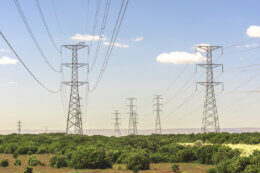
Hundreds of thousands of families and small businesses living and working in embedded networks across Australia are missing out on cheaper electricity plans, solar savings, rebates, concessions, rewards and other perks because of how expensive and complex it is for them to find their own electricity retailer.
Compare the Market is calling on state governments to shake up the energy sector by offering those in embedded networks access to greater choice and freedom when selecting an electricity retailer.
“At present, those in embedded networks – typically those living or working in apartment buildings, units, townhouses, retirement villages, caravan parks and shopping centres – usually pay their body corporate or site owner for electricity, rather than finding their own electricity retailer,” Compare the Market’s General Manager of Energy and Utilities, Brett Mifsud explains.
“The problem with this is that these customers don’t have a say in who their electricity retailer is, meaning they’re locked into a contract which usually has higher prices, no access to solar power or environmental benefits and have to pay large amounts of money if they want to switch or find a better deal.
“This isn’t fair and needs to change – especially as the energy sector continues to face unprecedented issues and Australians are paying higher prices for electricity across the board.”
All electricity in an embedded network is routed from poles and wires to residents through one primary electricity meter that’s managed by the site owner – who buys electricity in bulk from an electricity retailer, then sells it on to the tenants and residents. It’s the very structure of an embedded network that makes it difficult and often expensive for residents to find their own retailer.
“Firstly, they need to find an authorised retailer who offers an ‘energy only’ contract, which is a contract that doesn’t also charge for distribution costs or other services,” Mr Mifsud says. “Authorised retailers aren’t obliged to offer these contracts and while your exempt seller can’t stop you from seeking another retailer, they don’t need to help you find one either. It can be difficult to know where to start.”
If you do find an authorised retailer, you may then be required to purchase a new meter or pay to have your home’s wiring upgraded to accommodate a new meter and meet the current standards of your area – something Mr Mifsud says can be expensive.
“The cost can vary based on how old your home is, the way it’s wired, the meter your new retailer requires and the costs they charge for the upgrade,” Mr Mifsud says. “We do know that it can cost hundreds – if not thousands – of dollars, which may work out more expensive than what you’re paying your site owner for electricity. It’s also not a straightforward process, which is why so many people remain on the embedded network.
“If you’re a renter, you must also seek approval from your landlord, which is another step. They may refuse to pay for an upgrade, which means the cost would land on the renter. It simply needs to be easier for those on embedded networks to switch.”
| Mr Mifsud’s top tips for exiting an embedded network 1. Find an authorised retailer who can offer you an ‘energy only’ contract. The AER lists authorised retailers on its website, while the ESC lists retailers with electricity retail licences for Victorian customers. 2. Once you’ve secured an authorised retailer, inform your current exempt retailer (your body corporate or site owner) and tell them your plans to switch. 3. Your exempt retailer will appoint what’s known as an Embedded Network Manager, who ensures the authorised retailer you’ve found can supply you with electricity. They can also provide you with your meter’s National Metering Identifier (NMI), which your new retailer will require to start providing you electricity. 4. Depending on your current meter and home, you may be required to purchase a new meter or have your home’s wiring upgraded at your own expense. If the existing meter is in working order, you may be able to purchase or rent it from your exempt seller. 5. Ensure that your new authorised retailer doesn’t charge you a network fee for transporting electricity to your home. This cost should still be billed to you by the previous exempt retailer. |
Furthermore, owners and managers of embedded networks in South-east Queensland, New South Wales, the Australian Capital Territory and South Australia don’t require authorisation from the Australian Energy Regulator (or Essential Services Commission in Victoria) to sell electricity onto residents like other electricity retailers do, making them an exempt retailer.
“While there are rules in place to protect those in embedded networks who buy electricity from exempt retailers, they’re nowhere near as strong as they are for other authorised electricity retailers, which leaves many vulnerable Australians in a tricky situation,” Mr Mifsud says. “We know some states, like Victoria, are strengthening their regulation around embedded networks, but more needs to be done elsewhere around Australia.”
For example, the maximum price that Victorians in embedded networks can be charged for electricity is the Victorian Default Offer – a capped electricity price that electricity retailers can charge those on default offers for power in their area.
While there’s a similar offer available for default plans in New South Wales, South-east Queensland, the Australian Capital Territory and South Australia known as the Default Market Offer, no such cap exists in these areas for those in embedded networks.
“We’d like other states around Australia to take Victoria’s lead and offer this cap, so site owners and body corporates don’t price gouge and overcharge those in embedded networks for their electricity,” Mr Mifsud says. “And while the Victorian Government is planning on banning embedded networks in new residential apartment buildings from 2023, they’re also working on moving all embedded networks into Victoria’s electricity licensing framework.
“This means residents in embedded networks in Victoria will soon have access to the same plans, protections and regulatory oversights as the rest of the state. We call on other states and territories to implement a similar framework.”
It’s worth noting that the NSW Parliament recently launched an inquiry into embedded networks across the state, where they will investigate the current framework and possible solutions to concerns from those in embedded networks.
As for now, Mr Mifsud encourages those in embedded networks to be savvy when it comes to their electricity usage.
“Making a few small changes here and there can make a big difference to your power bill,” Mr Mifsud says. “Things like installing insulation can increase the efficiency of your heating and air conditioner, while turning off appliances on standby power can reduce your energy usage significantly. Older appliances can also chew through more power, so replacing them with energy-efficient models can make a difference.”
| Mr Mifsud’s top tips for saving electricity in an embedded network 1. Invest in smart appliances, which allow you to remotely adjust appliances to improve energy efficiency. You may be able to increase a fridge’s temperature on colder days, control lighting and modify temperatures for air conditioning and heating. You can program your smart appliances to only work during off-peak times. 2. Set the heater to between 18°C and 20°C in winter. Each degree warmer you set it can add as much as 10% to your electricity usage. 3. Switch appliances you’re not using off at the wall. Standby power can be responsible for more than 10% of your home’s electricity usage. 4. Be smart about how you use appliances. Use natural light when you can, hang your washed clothes instead of using the dryer and avoid using heat-dry setting on your dishwasher. |
For more information, please contact:
Phillip Portman | 0437 384 471 | [email protected]
Compare the Market is a comparison service that takes the hard work out of shopping around. We make it Simples for Australians to quickly and easily compare and buy insurance, energy, travel and personal finance products from a range of providers. Our easy-to-use comparison tool helps you look for a range of products that may suit your needs and benefit your back pocket.







